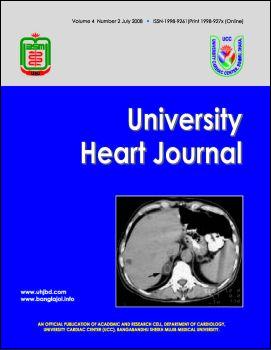Correlation of Doppler echocardiography with cardiac catheterization in estimating pulmonary capillary wedge pressure: A tertiary level hospital finding in Bangladesh
DOI:
https://doi.org/10.3329/uhj.v4i2.2065Keywords:
Pulmonary Capillary Wedge Pressure, Cardiac Catheterization, Doppler echocardiography, BangladeshAbstract
This prospective cross sectional study was conducted in the department of cardiology in National Institute of Cardiovascular Diseases (NICVD), Dhaka during the period of January 2002 to December 2002.Atotal of 50 patients with coronary artery disease subjected to diagnostic cardiac catheterization for evaluation of CAD were studied and the patients were grouped into two groups, group I having PCWP â¥12- < 18 mmHg and group II having PCWP â¥18 mmHg. The aims of the study were to correlate the Pulmonary Capillary Wedge Pressure (PCWP) estimated by Doppler echocardiography with that obtained at cardiac catheterization. Among 2D and M mode echocardiographic indices it was observed that ejection fraction was significantly lower and maximal left atrial volume (MLAV) was significantly higher among patients having PCWP â¥18 mmHg (p < 0.05). Among Doppler derived mitral flow variables deceleration rate was significantly higher (p < 0.05) among patients having PCWP â¥18 mmHg. No statistically significant difference was found between two groups in terms of pulmonary venous flow variables. A statistically significant negative correlation of deceleration time (r=-0.483; p=0.001) and ejection fraction (r=-0.334; p=0.01) and a statistically significant positive correlation of peak E wave (r=0.345; p=0.01) and deceleration rate (r=0.651; p=0.001) was found with catheter derived PCWP. The correlation coefficient between measured and estimated PCWP (from equation 1) was (r=0.678) which was highest. When pulmonary venous flow variables were included with mitral flow variables into multiple linear regression analysis, the resulting correlation coefficients were (r=0.670) for equation 2 and (r=0.652) for equation 3. In all three equations deceleration rate was the most important determinant of PCWP. Therefore in patients with coronary artery disease pulmonary capillary wedge pressure can reliably be estimated by combining Doppler echocardiographic variables of mitral flow and pulmonary venous flow and that mitral flow velocity indexes contribute most significantly to such estimation. Among the mitral flow variables, deceleration rate is the most important determinant of PCWP.
Key words: Pulmonary Capillary Wedge Pressure, Cardiac Catheterization, Doppler echocardiography, Bangladesh. Â Â
doi:10.3329/uhj.v4i2.2065
University Heart Journal Vol. 4 No. 2 July 2008 p1-8
Downloads
136
148

